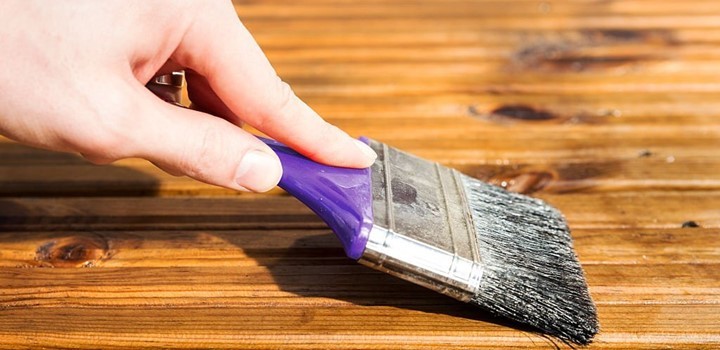Linseed Oil Over Stain: Is it Possible?
Linseed oil and flaxseed oil are the same. But, linseed oil is a popular substance for wood finishing. Because this oil is eco-friendly and easy to use. To preserve the color appearance, this linseed oil keeps and enhances the color of the wood.
Plus, this oil doesn’t need much preparation before applying. Moreover, you can reapply this oil easily at home when you will see any changes in your wood furniture.
Are you confused about whether linseed oil over stain is possible or not?
Well, don’t worry. Because it is possible to use linseed oil over stains. In fact, linseed oil is used to preserve the wood color because it helps the woodworkings to show the real golden brown color texture. You can apply this oil easily and you can reapply this oil too to maintain the color and complexion of your wooden finishing.
Read along to know how to use linseed oil over the stain and transform your interior-
What's On the Page
- 1 Is It Possible to Apply Linseed Oil Over Stain?
- 2 How to Apply Linseed Oil?
- 3 Why Is Linseed Oil Popular for Smooth Finishing?
- 4 Advantages of Using Linseed Oil Over Stain
- 5 Problems of Using Linseed Oil Over Stain
- 6 Are There Any Alternatives?
- 7 Tips & Tricks to Get The Best Result
- 8 Precautionary Actions While Applying Linseed Oil Over Stain
- 9 Usage of Linseed Oil Over Varnish & Protection of Woods
- 10 FAQs
- 11 Conclusion
Is It Possible to Apply Linseed Oil Over Stain?
Linseed oil can be used over stains. When the linseed oil dries out, it becomes non-transparent and gets mixed up with the wooden surface texture.
The linseed oil is a thick coating finish for making a shiny appearance on the wooden surface but you need to give time to let it dry. In the end, you must use a cloth to remove the extra to be away from overflowing.
How to Apply Linseed Oil?

First, understand the stain substances. If you have oil-based stains, coat them with boiled linseed oil or dilute them with mineral spirits. In other cases, you can get linseed oil-based coatings by simply following these steps.
First off, you’ll need to ensure the proper penetration. For doing that, you’ll need to sand the surface first.
Then, clean the dust from the surface. The first coating preparation can be done with a brush, roller, or cloth.
Next, you must clean the excess oil from the surface or you will have a sticky wooden surface. After two to three coats, let it dry. The drying time is 12-24 hours.
Important: if you notice any color or texture changes in the wood, reapply a light layer of coating with a wet cloth.
Why Is Linseed Oil Popular for Smooth Finishing?
Linseed oil which is known as flaxseed oil is popular for smooth finishing. Also, linseed oil can be used as a final coating on wood without fear of it turning yellow. This is a better choice for coating because it rarely yellows.
Other than that, linseed oil also dries faster than other oils. So, it has an overall faster drying process. Also, it is easy to maintain the inside woodworkings.
Linseed oil has a relatively mild scent and a lighter color when sprayed or brushed on wood furniture.
Advantages of Using Linseed Oil Over Stain
Linseed oil is environmentally friendly and safe to use. So, you don’t need to worry about anything while using this oil.
In addition to that, linseed oil improves the quality of the appearance of colors and the complexion of the woodworkings. For this reason, it helps to bring out the true essence of the woods.
Other than that, linseed oil helps to remove cracks, holes, or stains with the use of the sandpaper. As a result, it contributes to the smooth textured finish.
But, do you know a fantastic fact about this oil? Well, it helps to defend against any disruptions in times of humidity. However, in this way, it manages to reach deep down to the wood structure.
Lastly, it has the greatest feature of protecting the wood layers by adding an extra thin layer of linseed oil to add a barrier.
It can be used in different other polishes as well to make a smooth and protective finish. For example, you can use this one way to make a good finish.
Problems of Using Linseed Oil Over Stain
There may be some issues with linseed that you need to be aware of. For example, linseed oil occasionally needs to be re-oiled.
This oil can also turn yellow over time. Then again, it’s easy to reapply. This is a problem with many wood finishes. So, be aware and do your own research before choosing any oils.
Besides this, if you are confused about linseed oil vs polyurethane, then I would say that it has been proved for a long time that linseed oil is a better choice than polyurethane because it is less likely to be yellow.
You may also be aware of another issue with linseed oil. If colorful substances soak into the wood, it is susceptible to discoloration. This oil coating may also leave water stains.
Above all, weather changes or humidity can cause linseed oil to transform and damage wood surfaces.
Are There Any Alternatives?
Well, there are options for using alternatives instead of linseed oil. For example, you can use polyurethane coating, sunflower oil, walnut oil, or safflower oil.
If you choose polyurethane coating, keep in mind that it will yellow with time. You may also use tung oil, which is comparable to linseed oil and is similarly liquid-resistant. But, it’s difficult to apply.
Another option is Danish oil, which provides a long-lasting finish, particularly for pine furniture.
Tips & Tricks to Get The Best Result
To get the best result, here’s the tip that you can follow to get a smooth reliable finishing.
- You can put polyurethane coating first
- Then add the linseed oil to finish the coating.
It gives the best result. It just mixed up in the right amount and gives the smoothest finishing. But if you use them separately you have to sacrifice some benefits because you know everything has some backlashes. But adding these two oils work the best.
Precautionary Actions While Applying Linseed Oil Over Stain
In terms of using boiled linseed oil, you have to be careful about the heating process.
Besides, if you apply linseed oil to surfaces using clothing instead of a brush or roller, take precautions. If you do nothing, an exothermic reaction may occur. You must dip your clothes in water to avoid a fire. But you may dispose of wet clothes in a plastic bag.
Usage of Linseed Oil Over Varnish & Protection of Woods
Linseed oil can replace varnish as a topcoat. Plus, the oil is a great substitute for varnish because it preserves the wood while also keeping the surface moist and preventing shrinkage.
To protect the wood from damage, linseed enters the gaps between the wood grains. Because it penetrates so deeply, the wood retains its natural appearance.
And when it comes to the protection of wood from stains, you need to mix oil-based substances.
To remove stains or protect the wood, dilute the stains with boiled linseed oil. This is why linseed oil finish is popular and worth using.
FAQs
Does Linseed Oil Change Wood Colour or Nature?
Linseed oil products will darken with time, especially if kept in low light. Adding linseed oil to wood changes its color somewhat. It’s a golden brown that yellows with time.
When it comes to linseed oil, linseed oil vs boiled linseed oil- what is preferable?
Drying boiled linseed oil takes longer than drying raw linseed oil. Because boiled ones need to be heated and maybe blown with hot air to speed up the drying process. Except for oak, boiling ones should be used on other woods.
Is it true that boiling linseed oil darkens wood?
Both types of linseed oil get darker in the absence of light. However, when the woods with the coatings of linseed oil are exposed to UV light, it gets darker.
Is it possible to use linseed oil with wood stain?
Yes, it is possible and it works. Raw linseed oil is great for wood finishing however, to use linseed oil with wood stains, you have to use mineral spirits or boiled linseed oil.
Conclusion
To wrap up, have you got all your answers about linseed oil over stain?
The advantages of linseed oil over alternative coatings are many. Linseed oil protects the wood from scratches and holes. This oil also maintains the woods nourished since it adjusts to the weather and changes the humidity.
We’ve discussed all of the details in this guide. Hope this helps! Adios!

Robert Larry is a woodworking enthusiast, carpenter, creative wood art designer, and spokesperson. He has a passion for crafting unique and functional pieces from wood, and over the years, He has honed his skills to develop a distinctive style that blends traditional carpentry techniques with a modern, artistic touch.
In addition to his work as a carpenter, He is also a writer, sharing his knowledge and experiences through articles and blog posts on the craft of woodworking. With a keen eye for detail and a deep appreciation for the natural beauty of wood, He creates pieces that are not only functional but also beautiful works of art.

![How To Keep Painted Cabinets From Chipping?[3 Simple Methods]](https://carpentinglab.com/wp-content/uploads/2022/04/How-To-Keep-Painted-Cabinets-From-Chipping.jpg)
![Does Cedar Wood Rot? [Mystery Solved]](https://carpentinglab.com/wp-content/uploads/2021/10/Does-Cedar-Wood-Rot.jpg)

![How to Make Wood Fireproof? [Answered Properly]](https://carpentinglab.com/wp-content/uploads/2022/04/How-to-Make-Wood-Fireproof.jpg)


